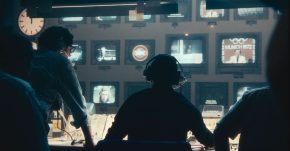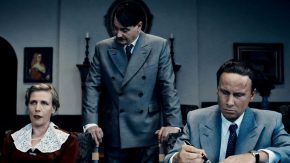Solus Amor (‘only love’) is the third part of a trilogy of the Recirquel that will be played in the Müpa for the first time between the 15th and 18th of October. By the time Non Solus was made, nobody knew that there would be two more, and with My Land, the company invented a new genre. I asked founder and artistic director Bence Vági about the third piece that you can also enjoy on its own.

How is this trilogy built up?
Non Solus was the first example for the new artistic direction of our company. This is a two-person piece depicting the relationship between body and soul: there was birth in it, when soul moves in the body, then their coexistence, and finally how soul departs to universe when we die. We did not know then that there will be two more parts as well. The second, My Land, was about the relationship between humans and the Earth: how do we connect to our planet, our homeland, how are we present in each other.
Solus Amor examines in a broader sense how important love is for us humans on this planet, how we perceive this central energy, which is too often like a cliché, but probably the most important element of human life. This connects the trilogy: all pieces are about new and new dimensions of humanity. Each piece is an individually enjoyable artwork, but of course if one knows all of them, surplus depths and arcs can be discovered. It is very important that not only the topics connect the three parts but the genre created by our company: cirque danse.
How was this new genre born?
Our production My Land visited Edinburgh at the Fringe Festival where dozens of reviewers write about the performances, also marking them with stars. In the end it turned out that our piece received the most stars, so at the whole international festival among 4200 productions, we ended up in first place. Every reviewer noted it looks like a new genre: someone called it circus ballet, another one circus dance, yet another circus-dance theatre. This is how we ended up with this name, cirque danse, to describe this brand new form of performance.
Where is circus and where is dance in it? How are they mixed?
Since the very beginning of our company, it was a leading idea, and also an important preference of hiring acrobats, that they can move like dancers. After they joined us, they received a dance education, meanwhile dancers were educated in acrobatics. This cross-training created the genre.

Circus is basically about astonishment, magic, whereas dance is more like self-expression: a standalone language, a movement-language. The two genres have a great impact on each other, as acrobatics highlights dance and gives it even more attention, whereas dance in acrobatic movements opens the door for even more storytelling. This is a fruitful cooperation, no wonder that this new genre is popular already, and our performances are acknowledged worldwide.
Are these pieces really telling a story with beginning-peak-end?
None of the two genres are really meant to tell a linear story, they are much more lyrical – it is more like a poem. Everyone interprets it in a different way, everyone has a different mark left on their soul, although reviews usually show that people understand what we aim to say. Those general topics, giant pictures that we are sketching, painting, are all different imprints. Experiencing it also resembles to looking at a painting: someone “simply” finds it beautiful, but someone else can feel how subconscious depths are moving, how the artwork connects to their life, one or other important aspect of it. This is indeed what theatre is about: we identify with a figure, feel what they feel, and this can be the beginning of a healing – maybe even therapeutic – process. Good theatre makes your soul heal and grow.
This is beautiful…! Who exactly is behind the production?
We have a big team: I am the director-choreographer, my acrobatics-co-choreographer is Renátó Illés, my director assistants are Gábor Zsíros Gábor and Aliz Schlecht. Composer is Edina Mókus Szirtes, the set designer is Péter Klimó, the costume designer is Emese Kasza. The visual elements of the production are also there to help us express our thoughts in an even more enchanting way. Acrobats are actively involved in that, and we have fantastic acrobat-coaches, these few names are only the tip of the iceberg. This is a huge teamwork, and the end result is a performance that the audience can see.

How did the pandemic influence the preparations?
We had a lot of difficulties to face. Acrobats are all Hungarian in this piece, but we had a collaborator from South Africa, Janni Younge. We worked with a fascinating puppet maker team who designed, for instance, the totally real-looking horse puppets for the western production Warhorse. This time, Janni Younge created an ancient polar bear for us who had to come straight from South Africa, and it was horribly hard to organise with all the border closures. But finally, the polar bear arrived, just like the coach who instructed the acrobats and dancers about the right movements.
What does a polar bear do in such a piece?
The relationship between humans and the biosphere plays an important role in this piece about love, as the present and future of humanity truly depends on how much love and affection we give to other living beings. Polar bear is a very strong symbol, as this species is horribly suffering from the destruction of our environment. In this sense, this is a strong connection between Solus Amor and My Land.
How could acrobats train during the lockdown?
That was a crucial question for us, as acrobats are very similar to professional sportspeople in how inevitable the daily training is. You cannot hear about acrobats who went on three-week holidays without training. Those bodily deformities that make special movements in the air possible, like the wrist twisting completely, have to be kept on their usual level. If that does not happen for 2-3 weeks, then body “turns back to normal”, and the extraordinary ability and knowledge gets lost. Therefore, while in lockdown, acrobats were all training and exercising at home. After lockdown ended, Hungary was relieved, but for us, the very serious quarantine only started at that point. Artists were only moved between their homes and the rehearsal halls, they did not meet friends outside the company, and someone even moved out from their parents’ home. We only met each other at the rehearsals, otherwise everyone stayed isolated just like before. Naturally, it required a lot of self-discipline, but for this piece, I can assure you that it was totally worth it!



























Comments
1 Responses to “Recirquel shows us love, but what about the polar bears? – interview with Bence Vági”